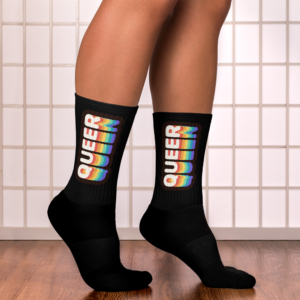Understanding gender identity can be an important conversation to have with our children, especially if they identify as LGBTQ+. We all want our youth to feel affirmed and supported in their journey toward self-discovery. Our culture is increasingly discussing the importance of gender equality, making it even more necessary for parents to be informed on what gender identity means so we can best support our family members. This blog post aims to explain the various aspects of gender identity and expression and give helpful tips for families wanting to create affirming environments for their loved ones. We hope by informing you on these topics, compassion, and understanding will extend between family members and queer youths alike!
Our identities are made up of many wonderful parts – traits like our culture, sexuality, religion, age, body, gender, and lots more. Our identities are personal, no one can tell you how to identify. You are who you are.
What is Gender Identity?
It is your sense of whether you are a man, woman, nonbinary, gender fluid, or a combination of one or more of these identities. It is part of your sense of self and how you understand who you are and how you interact with others.
For many people, their understanding of who they are, and their gender identity, will match their sex. This is called being cisgender (pronounced sis-gender).
For some people, their gender identity might not match the sex they were assigned at birth and these individuals might choose to identify as transgender (e.g., being assigned female at birth, but identifying as a man).
We think it is important to remember that there is more to gender than just being a ‘male’ or ‘female’. Some people understand their gender as being a combination of both male and female, or neither. These people might choose to identify as being gender diverse or non-binary. There are various words people choose to describe their gender identity.
The words people use to describe their gender identity are very personal. Some people choose to share their gender identity using pronouns (like he/him, he/they, she/her, they/her, and they/them; these are just some examples). Other ways of expressing gender identity (gender expression) refer to the way people publicly express their gender and may include how they behave, their appearance, or what they choose to wear.
Understanding and embracing your true identity is a journey – no two people’s experiences are the same. It doesn’t matter when or how you decide to label yourself, it only matters that you choose what feels right for you at the time! Having confidence in knowing whatever gender identity fits YOU best can change over time; feeling comfortable with who we truly are should always be celebrated!

Exploring your gender identity can be a beautiful experience! You have the freedom to express who you are beyond what sex was assigned at birth. Gender isn’t limited to just ‘male’ and ‘female’, as there is now an array of diverse identities that allow people to recognize their true selves in whatever way they wish. Whether you identify with one label or none, it’s important to remember that how you feel about yourself should always take priority; allowing everyone a safe space where we can own our truth without judgment – this is essential for any journey towards self-discovery and acceptance.
Gender Identity and Mental Health
Despite the presence of obstacles, young people who are gender diverse or do not conform to traditional social expectations have grand opportunities for meaningful lives. Unfortunately, this population can be subject to negative attitudes and discriminatory behavior which may lead them down a dark path toward depression, anxiety, self-harm, and even suicide. Diversity of gender can be a powerful force for good, with inclusion and understanding creating stronger mental health outcomes.
Why might this be difficult for me? How do I know if I’m struggling with my mental health?
Doing our best to take care of ourselves mentally is critical. If daily life tasks are feeling particularly challenging, or if worries and stressors linger for longer than expected, it’s time to reach out for support – seeking guidance can help alleviate symptoms before the problem escalates further. Let’s look after each other – mental health matters!
Some transgenders or gender-diverse young people find it especially hard to ask for help.
This might be because of discrimination by health professionals in the past, worries about privacy, or difficulty talking to strangers about gender identity.
It’s important to find someone you can trust to support you throughout your journey. This might include family members or members of your chosen family. This might be your general practitioner (GP) and/or other health professionals experienced in working with gender-diverse young people.
Finding the right person to talk with about your gender identity can be a daunting task – but if you don’t connect with someone, it’s okay. Don’t give up on finding support; reach out to those close to you for recommendations that could help point in the direction of an understanding and experienced health professional who is best suited for YOU. Remember too: there is no obligation whatsoever when discussing this important topic – always feel safe knowing the decision to do so rests ultimately within yourself!
Follow Equal Ideas at:
Web: www.equalideas.com
Instagram: https://www.instagram.com/equal.ideas
Facebook: https://www.facebook.com/EqualIdeas
Pinterest: https://www.pinterest.com/equalideas
Showing all 4 results
-

Transtastic Stainless Steel Water Bottle
$27.50 Add to cart -

Queer Representation Mugs with Color Inside
$16.50 – $17.00 Select options This product has multiple variants. The options may be chosen on the product page -

LuxeComfort Queer Cushioned Socks
$17.75 Select options This product has multiple variants. The options may be chosen on the product page -

Printed Shirt Transtastic Gender-Free Statement Tee
$29.95 Select options This product has multiple variants. The options may be chosen on the product page

0 comments